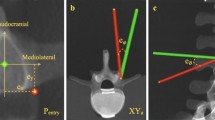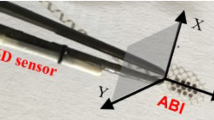Abstract
Purpose
During medical needle placement using image-guided navigation systems, the clinician must concentrate on a screen. To reduce the clinician’s visual reliance on the screen, this work proposes an auditory feedback method as a stand-alone method or to support visual feedback for placing the navigated medical instrument, in this case a needle.
Methods
An auditory synthesis model using pitch comparison and stereo panning parameter mapping was developed to augment or replace visual feedback for navigated needle placement. In contrast to existing approaches which augment but still require a visual display, this method allows view-free needle placement. An evaluation with 12 novice participants compared both auditory and combined audiovisual feedback against existing visual methods.
Results
Using combined audiovisual display, participants show similar task completion times and report similar subjective workload and accuracy while viewing the screen less compared to using the conventional visual method. The auditory feedback leads to higher task completion times and subjective workload compared to both combined and visual feedback.
Conclusion
Audiovisual feedback shows promising results and establishes a basis for applying auditory feedback as a supplement to visual information to other navigated interventions, especially those for which viewing a patient is beneficial or necessary.







Similar content being viewed by others
References
Arnolli MM, Hanumara NC, Franken M, Brouwer DM, Broeders IA (2015) An overview of systems for CT- and MRI-guided percutaneous needle placement in the thorax and abdomen. Med Robot Comput Assist Surg 11(4):458–475
Beller S, Hünerbein M, Eulenstein S, Lange T, Schlag PM (2007) Feasibility of navigated resection of liver tumors using multiplanar visualization of intraoperative 3-dimensional ultrasound data. Ann Surg 246:288–294
Black D, Kocev B, Meine H, Nabavi A, Kikinis R (2016) Towards uncertainty-aware auditory display for surgical navigation. In: Proceedings of gesellschaft für computer- und roboterassistierte chirurgie (CURAC), Bern, Switzerland
Cash DM, Miga MI, Glasgow SC, Dawant BM, Clements LW, Cao Z, Galloway RL, Chapman WC (2007) Concepts and preliminary data toward the realization of image-guided liver surgery. Gastroint Surg 11:844–859
Chen X, Wang L, Fallavollita P, Navab N (2013) Precise X-ray and video overlay for augmented reality fluoroscopy. Int J Comput Assist Radiol Surg 8(1):29–28
Cho B, Oka M, Matsumoto N, Ouchida R, Hong J, Hashizume M (2013) Warning navigation system using realtime safe region monitoring for otologic surgery. Comput Assist Radiol Surg 8:395–405
Dixon BJ, Chan H, Daly MJ, Vescan AD, Witterick IJ, Irish JC (2012) The effect of augmented real-time image guidance on task workload during endoscopic sinus surgery. Int Forum Allergy Rhinol 2:405–410
Dixon BJ, Daly MJ, Chan H, Vescan AD, Witterick IJ, Irish JC (2013) Surgeons blinded by enhanced navigation: the effect of augmented reality on attention. Surg Endosc 27(2):454–461
Dixon BJ, Daly MJ, Chan H, Vescan AD, Witterick IJ, Irish JC (2014) Augmented real-time navigation with critical structure proximity alerts for endoscopic skull base surgery. Laryngoscope 124:853–859
Fischbach F, Bunke J, Thormann M, Gaffke G, Jungnickel K, Smink J, Ricke J (2011) MR-guided freehand biopsy of liver lesions with fast continuous imaging using a 1.0-T open MRI scanner: experience in 50 patients. Cardiovasc Interv Radiol 34:188–192
Haerle SK, Daly MJ, Chan H, Vescan AD, Witterick I, Gentili F, Zadeh G, Kucharczyk W, Irish JC (2015) Localized intraoperative virtual endoscopy (LIVE) for surgical guidance in 16 skull base patients. Otolaryngol Head Neck Surg 152:165–171
Hansen C, Black D, Lange C, Rieber F, Lamad W, Donati M, Oldhafer K, Hahn H (2013) Auditory support for resection guidance in navigated liver surgery. Med Robot Comput Assist Surg 9(1):36–43
Hansen C, Wieferich J, Ritter F, Rieder C, Peitgen HO (2013) Illustrative visualization of 3D planning models for augmented reality in liver surgery. Int J Comput Assist Radiol Surg 5(2):133–141
Hansen C, Zidowitz S, Ritter F, Lange C, Oldhafer K, Hahn HK (2013) Risk maps for liver surgery. Int J Comput Assist Radiol Surg 8(3):419–428
Hart SG (2006) NASA-Task Load Index (NASA-TLX); 20 years later. In: Human Factors and Ergonomics Society 50th annual meeting. HFES, Santa Monica, pp 904–908
Hermann T (2008) Taxonomy and definitions for sonification and auditory display. In: 14th international conference on auditory display, Paris, France
Kersten-Oertel C, Jannin P, Collins DL (2012) DVV: a taxonomy for mixed reality visualization in image guided surgery. IEEE TVCG 18(2):332–352
Luz M, Manzey D, Modemann S, Strauss G (2015) Less is sometimes more: a comparison of distance-control and navigated-control concepts of image-guided navigation support for surgeons. Ergonomics 58:383–393
Marcus HJ, Pratt P, Hughes-Hallett A, Cundy TP, Marcus AP, Yang GZ, Darzi A, Nandi D (2015) Comparative effectiveness and safety of image guidance systems in neurosurgery: a preclinical randomized study. J Neurosurg 123(2):307–313
Peterhans M, Oliveira T, Banz V, Candinas D, Weber S (2012) Computer-assisted liver surgery: clinical applications and technological trends. Crit Rev Biomed Eng 40:199–220
Puckette, M (1996) Pure Data: another integrated computer music environment. In: Second intercollege computer music concerts, pp 37–41
Voormolen EH, Woerdeman PA, van Stralen M, Noordmans HJ, Viergever MA, Regli L, van der Sprenkel JW (2012) Validation of exposure visualization and audible distance emission for navigated temporal bone drilling in phantoms. PLoS ONE 7:e41262
Walker BN, Nees MA (2011) Theory of sonification. In: Hermann T, Hunt A, Neuhoff J (eds) Handbook of sonification. Academic Press, New York
Wegner K, Karron D (1998) Audio-guided blind biopsy needle placement. Stud Health Technol Inform 50:90–95
Willems PW, Noordmans HJ, van Overbeeke JJ, Viergever MA, Tulleken CA, van der Sprenkel JW (2005) The impact of auditory feedback on neuronavigation. Acta Neurochir (Wien) 147:167–173
Woerdeman PA, Willems PW, Noordmans HJ, van der Sprenkel JW (2009) Auditory feedback during frameless image-guided surgery in a phantom model and initial clinical experience. Neurosurgery 110:257–262
Wright M, Freed A (1997) Open sound control: a new protocol for communicating with sound synthesizers. In: Proceedings of the 1997 international computer music conference
Wright M, Freed A, Momeni A (2003) OpenSound control: state of the art 2003 In: Proceedings of the 2003 conference on new interfaces for musical expression, pp 153–160
Acknowledgements
The work of this paper is partly funded by the German Research Foundation (DFG) under Grant Number HA 7819/1-1, and the Federal Ministry of Education and Research within the Forschungscampus STIMULATE under Grant Number 13GW0095A.
Funding was also provided by Neuroimaging Analysis Center (Grant No. P41 EB015902), Image Guided Therapy Center (Grant No. P41 EB015898), Accelerating Community-Driven Medical Innovation with VTK (Grant No. R01EB014955), Quantitative Image Informatics of Cancer Research (QIICR) (Grant No. U24CA180918).
Author information
Authors and Affiliations
Corresponding author
Ethics declarations
Conflict of interest
The authors declare that they have no conflict of interest.
Informed consent
Informed consent was obtained from all individual participants included in the study.
Rights and permissions
About this article
Cite this article
Black, D., Hettig, J., Luz, M. et al. Auditory feedback to support image-guided medical needle placement. Int J CARS 12, 1655–1663 (2017). https://doi.org/10.1007/s11548-017-1537-1
Received:
Accepted:
Published:
Issue Date:
DOI: https://doi.org/10.1007/s11548-017-1537-1




